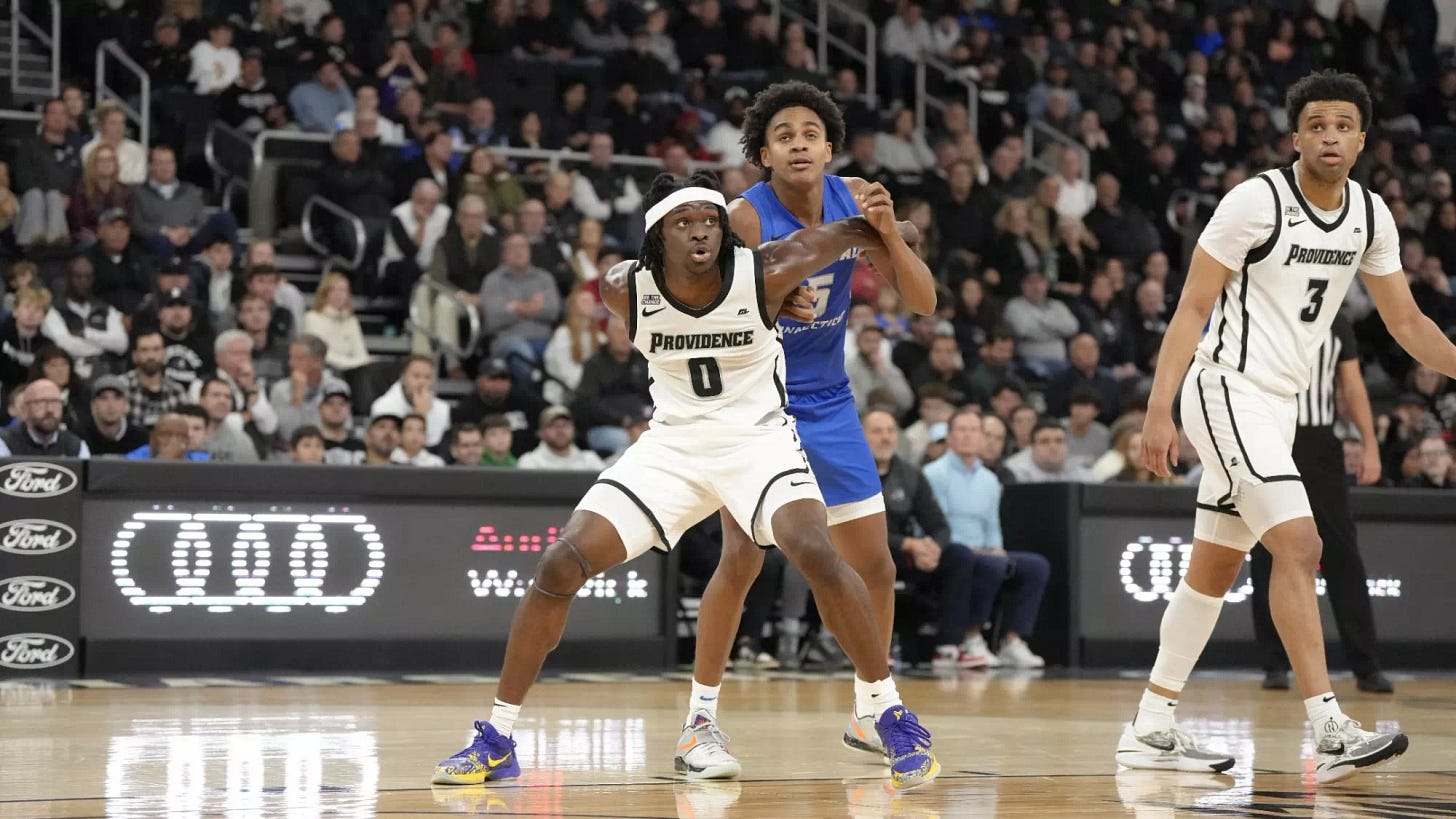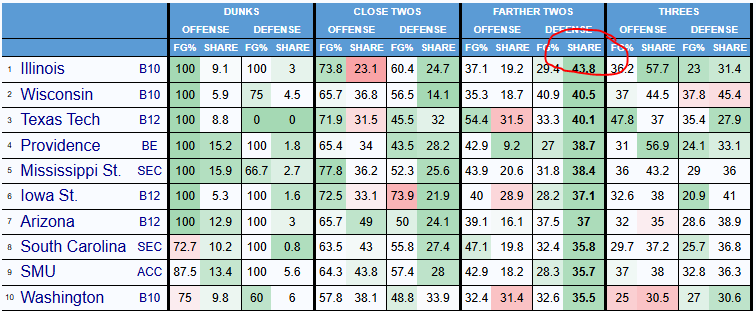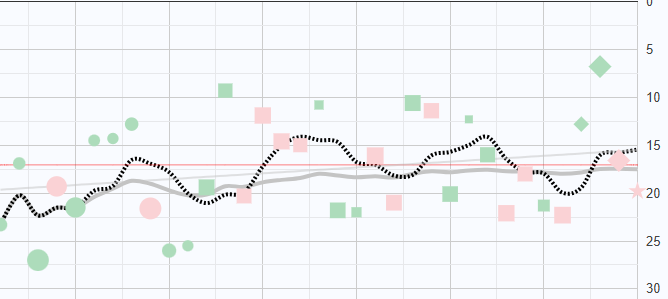'Offense is back' in college basketball, but not in Friartown
The Friars are struggling to score while also stifling opponents -- today, I consider the whys of both
The headline to Ken Pomeroy’s substack article on Thursday blared “Offense Is Back!” but you’d have to forgive Providence Friars fans if they hadn’t noticed. Through the first nine days of the season (ending the night PC played Hampton on Tuesday), teams were averaging 104.6 points per 100 possessions, an all-time in the era where we have this data (since 1996-97) for the start of a season. The average team is scoring 74 points per game through Wednesday.
Here in Friartown, though, it feels more like the pre-shot clock era. The average score of PC’s opening wins vs. Central Connecticut, Stonehill and Hampton was 65-52. The Friars have been bang-on a point per possession while holding their opponents to a paltry 0.80. If one considers BartTorvik.com’s adjustments for the quality of competition (normalizing performance for what it would be vs. an average D1 team, PC is scoring and allowing an adjusted 0.90 points per possession, which means the Friars’ offense is well below average and their defense well above. Oh, and Providence’s adjusted tempo is 323rd in the country (out of 364 teams).
So, what’s going on?
Let’s start with the part of not scoring that Friars fans have to be happy with and that’s on the defensive end. The Friars have the second-best field-goal defense in the country (34.7% eFG) and have been stingy on the glass as well (49th nationally). Despite the offensive limitations of the Friars’ centers to date, the interior defense has backed up a perimeter defense led by strong, athletic guards and wings. The defense has been so tough that opponents are taking nearly 20 seconds to even get a shot off, the ninth-longest average opponent possession length in the country to date.
The philosophy is simple to express but harder to put into effect: don’t give up open 3-point looks and keep teams away from the rim, which means force mid-range jumpers or contested threes. Last year, the Friars took this philosophy from Coach Kim English and his staff and turned that into a top-five defense (again, per BartTorvik) until Bryce Hopkins was lost for the season with a knee injury on Jan. 3. The Friars’ defense was a bit more ho-hum after that (closer to top-50 than top-five), but it was still the team’s strength, led by an elite defender in Devin Carter and two experienced, reliable bigger players in Josh Oduro and Ticket Gaines but not much depth behind it.
That defensive philosophy and execution have carried over to this season. Even adjusting for the poor competition, the Friars have been stifling on defense, running out physical guards like Corey Floyd Jr. and Wesley Cardet and bringing in length and activity behind them in Ryan Mela, Jabri Abdur-Rahim and Justyn Fernandez. Even Eli DeLaurier, who barely saw the floor through two games, came in against Hampton and had a steal, two blocks and three rebounds in just 12 minutes while playing as a skinny 5 man.
Apart from the personnel, the aforementioned emphasis on opponent “shot diet” — what shots you want the opponent to take and which ones you want to prevent — is key to sustained defensive excellence. The Friars have been elite at forcing opponents to take the shots PC wants them to.
I’ve circled in red the operative column here. This is a sort of all power-conference teams in order of the share of shots they are forcing in the mid-range (i.e., “farther twos”) so far this season. The Friars are fourth-best and, moreover, PC opponents have the lowest shooting percentage among those top 10 teams. That shooting percentage may regress, but the philosophy of forcing mid-range shots is sound. The Friars are also top-20 in fewest shots at the rim and fewest threes allowed. Some of this is competition, but a lot of these major-conference teams have played terrible opponents, too. Last season, PC was top-20 in most mid-range shots forced and fewest threes allowed and top-30 (of 94) in fewest rim attempts. Hence, this is a pattern.
And here’s why English is so focused on forcing mid-range shots – last season, the median major-conference team scored 0.77 points per mid-range shot, 1.20 points per close 2-point attempt and 1.04 points per 3-point attempt. In other words, for every rim attempt you turn into a mid-range shot, you gain nearly a half-point in expected outcome. This is why the Friars play drop coverage on high ball screens – an open 15-footer is often a worse shot than even a contested look at the rim, not to mention that shots at the rim lead to more fouls (two free throws equal an expected 1.44 points) and more offensive rebounds (the most likely missed shot for a team to rebound is one at the rim). See this chart from a 2014 Ken Pomeroy article that showed the likelihood of an offensive rebound charted against shot type and time left in the game:
Some of what the Friars are doing is unsustainable – they don’t have the rim protection (I don’t think) to be a top-five 2-point defense, and 3-point defense (the Friars are 29th nationally, allowing a 24.1% by opponents on threes) always tends to regress toward, though not entirely to, the mean. But even if the Friars’ ability to get opponents to miss became utterly average, it would still be a good defense. Here’s why:
What the above chart shows is that the Friars are allowing the sixth-worst quality of field-goal attempts of any major-conference team in the country. I don’t want to diminish the small-sample nature of this data and that it comes against weak competition (the data above is not adjusted/normalized for competition at all), but the Friars’ defensive shot diet is as optimal as it gets.
Ed. note: The initial version of this post had incorrect data in the graphic above that showed Providence as first in this metric. I’ve corrected it above and apologize for the error.
I know I’ve buried the lede. Many are concerned with Providence’s anemic offense – I, too, am concerned. After 38 games in charge, we have yet to see English’s teams perform consistently like even a top-100 offense. My preseason column flagged three reasons for pessimism, all of which were prone to affect the offense and have been in full effect over three games:
Shot creation: In the Hampton game, especially, the Friars only created 11 attempts at the rim, after 19 and 21 in the previous two games. The Pirates threw a mix of defenses but were mostly focused on shutting down drives, and they succeeded. We’ve seen several players – Bensley Joseph, Cardet, Floyd, Jayden Pierre, Mela – show the ability to put the ball on the deck and get the rim, but in general, the rim drives have petered out in the mid-range, and, just like PC wants to force those shots, the Friars don’t want to take them. What’s called for, then, is a mix of creative finishing or proactive passing based on good court vision, but it’s not happening so far. Cardet, in particular, was superb at getting into the paint last year at Chicago State, but he’s looked indecisive through three games. Hopkins’ ensuing return (maybe this weekend??) will help, as will growing in comfort with this offense and as a team (and maybe figuring out a rotation). The Friars are just not consistently connected on offense. We’re not seeing a lot of off-ball cutting and movement to create pockets for passes that lead to layups (which is why Mela’s cut and DeLaurier’s look in the second half vs. Hampton sticks out). Guys are doing well at finding space for spot-ups but not generating a lot of passing to players moving toward the basket, and often the passes that have been attempted have led to…
Turnovers: This has been the headline through three games. The Friars have turned the ball over on 26% of possessions. We’ll talk more about Christ Essandoko later, but obviously he is a primary culprit here, sporting a mind-blowing 53% turnover rate. Even behind Essandoko, Joseph (24.9%), Pierre (23.4%), Rich Barron (23.8%) and Oswin Erhunmwunse (29.1%) have unconscionable turnover rates. I wrote that this team was likely to be prone to turnovers, and they are. The good news – it’ll get better. The upper bound for a Big East team is probably about a 20 or 21% turnover rate in an era where the national average is around 17%. Moreover, English’s teams see their turnover rates improve during the season. Like most data, it’s messy, but the trend line shows that, by season’s end last year, PC was probably a bit better than an average team in terms of ball protection even after having six games with 20+% turnover rates in the first 11. The Friars’ four worst turnover games all happened in that opening stretch in wins over Columbia, Wisconsin, Brown and Sacred Heart. Here is a plot of game-by-game turnover rate (the thin, gray line shows the season-long trend, and it’s positive):
Injuries: This factor is impacting the first two. The lack of time on the floor together is leading to a lack of cohesion. Players aren’t comfortable with where teammates are and even how they move or pass, and it’s causing confusion that leads to turnovers and just general unkemptness on offense. The good news is that we’re going on two weeks of everyone (save Hopkins) being on the floor and healthy. With time (and the Friars will have a full week of uninterrupted practice after playing Delaware State next Tuesday ), the team should become more cohesive, which will make the offense run more smoothly.
And I’ll add a fourth factor that I didn’t explicitly hit on in my preview:
Center play: Essandoko, Erhunmwunse and Anton Bonke came into the season with a combined one year of Division 1 basketball, and that should have been a red flag, but the sheer aggregated weight, length and athleticism made that concern easier to overlook. I documented Essandoko’s turnover issues at St. Joe’s last year, we knew Erhunmwunse would be offensively challenged and that Bonke was a project, but we expected more than this. Over three games, they are collectively averaging 9.3 points, 9.3 rebounds, 1.7 assists, 5.7 turnovers, 1 block and 0.7 steals and shooting 4-for-11 (36%) from the free-throw line. The Friars just need a bit more from this group (and also a bit less, in terms of turnovers). It starts with Essandoko limiting his mistakes and letting his talents and size take over. Otherwise, we could see a lot of smaller lineups with a DeLaurier at the 5 – he showed activity and rim protection vs. Hampton. Perhaps Hopkins even plays some there due to his strength, but I’m not sure the small lineups will fly for long in the Big East – plain and simple, they need more from Christ and Oswin for the offense to become competent.
I’ll leave with you with one reason for offensive optimism. The same “shot diet” data that shows why Providence is so good on defense also shows that the Friars are getting, by and large, the shots they want. The Friars are among the national leaders in share of 3-point attempts at 56% of all shots from the floor. They are taking more threes than all but three major-conference teams, which does feel a bit too many, though PC’s 31% hit rate will improve. And just like how the Friars force the fourth-most mid-range shots, they are taking the third-fewest. PC does need to get to the rim more — just 18 of 79 major-conference teams have a smaller share of rim attempts. The Friars have been too willing to take what the defense is giving them, which has been, for the most part, pretty good 3-point looks, rather than getting to the rim. Part of this is a lack of transition attempts – English talks about wanting to run, but they haven’t been able to do so effectively, and it’s in transition where a lot of rim attempts are generated.
Still, using that same expected points per shot measure that we used for defense, the Friars rate out pretty well.
You see that Providence has the worst share of rim attempts of anyone in that group and yet still makes the top 20 in overall shot quality. Cut down on the turnovers and, even without improving the types of shots they’re getting, the offense will get better. Add Bryce Hopkins and get more shots at the rim while cutting down on turnovers, and the offense might actually be interesting. With the quality of this defense, the offensive standard need not be all that high for the Friars to be OK. But the journey to “not all that high” from where PC is starting through three games is actually quite long.
It starts Saturday vs. Green Bay (one of the worst defenses in the country) and Tuesday vs. Delaware State, where all of us will be looking for signs of progress before the preliminaries are over and Feast Week sends the Friars to the Bahamas for the Battle for Atlantis.









